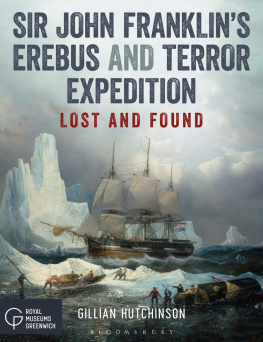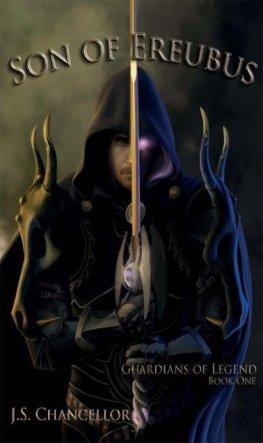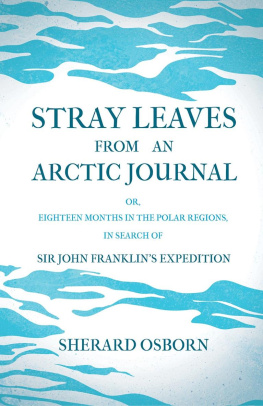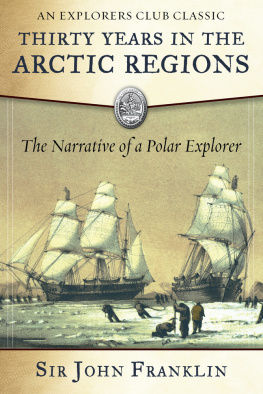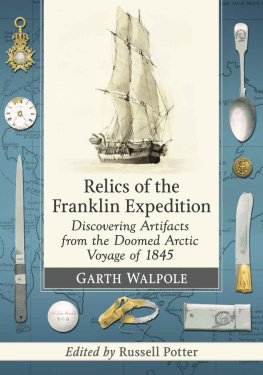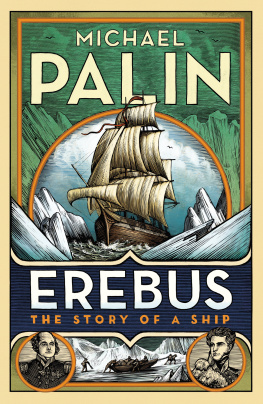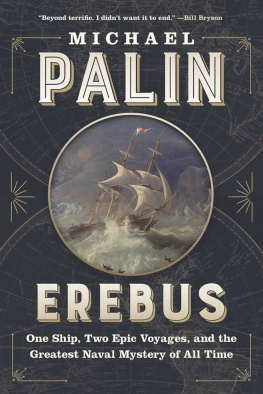Gillian Hutchinson - Sir John Franklins Erebus and Terror Expedition
Here you can read online Gillian Hutchinson - Sir John Franklins Erebus and Terror Expedition full text of the book (entire story) in english for free. Download pdf and epub, get meaning, cover and reviews about this ebook. year: 2017, publisher: Bloomsbury Publishing, genre: History. Description of the work, (preface) as well as reviews are available. Best literature library LitArk.com created for fans of good reading and offers a wide selection of genres:
Romance novel
Science fiction
Adventure
Detective
Science
History
Home and family
Prose
Art
Politics
Computer
Non-fiction
Religion
Business
Children
Humor
Choose a favorite category and find really read worthwhile books. Enjoy immersion in the world of imagination, feel the emotions of the characters or learn something new for yourself, make an fascinating discovery.
- Book:Sir John Franklins Erebus and Terror Expedition
- Author:
- Publisher:Bloomsbury Publishing
- Genre:
- Year:2017
- Rating:5 / 5
- Favourites:Add to favourites
- Your mark:
- 100
- 1
- 2
- 3
- 4
- 5
Sir John Franklins Erebus and Terror Expedition: summary, description and annotation
We offer to read an annotation, description, summary or preface (depends on what the author of the book "Sir John Franklins Erebus and Terror Expedition" wrote himself). If you haven't found the necessary information about the book — write in the comments, we will try to find it.
Sir John Franklins Erebus and Terror Expedition — read online for free the complete book (whole text) full work
Below is the text of the book, divided by pages. System saving the place of the last page read, allows you to conveniently read the book "Sir John Franklins Erebus and Terror Expedition" online for free, without having to search again every time where you left off. Put a bookmark, and you can go to the page where you finished reading at any time.
Font size:
Interval:
Bookmark:


Adlard Coles Nautical
An imprint of Bloomsbury Publishing Plc
| 50 Bedford Square | 1385 Broadway |
| London | New York |
| WC1B 3DP | NY 10018 |
| UK | USA |
www.bloomsbury.com
www.adlardcoles.com
This electronic edition published in 2017 by Bloomsbury Publishing Plc
ADLARD COLES, ADLARD COLES NAUTICAL and the Buoy logo are trademarks of Bloomsbury Publishing Plc
First published 2017
National Maritime Museum, 2017
Gillian Hutchinson has asserted her right under the Copyright, Designs and Patents Act, 1988, to be identified as Author of this work.
All rights reserved
You may not copy, distribute, transmit, reproduce or otherwise make available this publication (or any part of it) in any form, or by any means (including without limitation electronic, digital, optical, mechanical, photocopying, printing, recording or otherwise), without the prior written permission of the publisher. Any person who does any unauthorised act in relation to this publication may be liable to criminal prosecution and civil claims for damages.
No responsibility for loss caused to any individual or organization acting on or refraining from action as a result of the material in this publication can be accepted by Bloomsbury or the author.
British Library Cataloguing-in-Publication Data
A catalogue record for this book is available from the British Library.
Library of Congress Cataloguing-in-Publication data has been applied for.
ISBN: 978-1-4729-4869-4 (PB)
ISBN: 978-1-4729-4871-7 (eBook)
ISBN: 978-1-4729-4870-0 (ePDF)
To find out more about our authors and their books please visit www.bloomsbury.com where you will find extracts, author interviews and details of forthcoming events, and to be the first to hear about latest releases and special offers, sign up for our newsletters.
In association with Royal Museums Greenwich, the group name for the National Maritime Museum, Royal Observatory Greenwich, Queens House and Cutty Sark.
CONTENTS
PREFACE
Sir John Franklin set out with HMS Erebus and HMS Terror in 1845 on a voyage to find the North-West Passage. The ships disappeared into the Arctic, never to be seen again until their wrecks were discovered in 2014 and 2016.
This brief guide fills in the background to Franklins expedition and describes the attempts that have been made to find survivors and discover what happened. Mystery still remains, however. Will examination of the shipwrecks solve it?

FOREWORD
The 1845 expedition to the Arctic, commanded by Sir John Franklin, was the largest, best-equipped expedition that Britain ever sent north, yet it ended in tragedy. Back home, the deaths of its 129 men devastated families. The disaster was writ large upon the Victorian imagination, represented in art, theatre and music. Exactly what happened is still subject to speculation.
The objects that Franklin searchers brought back were displayed in the Painted Hall in Greenwich from the 1850s. They were literally brought over the road when the National Maritime Museum opened in 1937 and have been important to the Museum ever since. We are grateful to Greenwich Hospital, the Gell Muniment Trustees, the descendants of Leopold McClintock and others for the things that they have entrusted to us over time. All these objects remain enigmatic witnesses to the final days of Franklin and his crew.
The finds of HMS Erebus and HMS Terror are some of the most exciting maritime archaeological discoveries of recent years. Those who cooperated so successfully in locating them are to be congratulated. We are grateful to Parks Canada for lending some of the material recovered from the wrecks, and to the Government of Nunavut for allowing them to travel back to Britain for the first time, for display in the first major exhibition since the ships discovery, Death in the Ice: The Shocking Story of Franklins Expedition, at the National Maritime Museum from 14 July 2017 to 5 January 2018. Much of the material in this book will also go on display in the National Maritime Museums new Polar Worlds gallery from 2018 onwards. Now, tantalisingly, the possibility of further explanation for the crews deaths exists.
It has been an enormous pleasure to work in collaboration with the Canadian Museum of History, sharing mutual expertise and collections to produce the Death in the Ice exhibition. The Canadian High Commission in London has also been a stalwart source of help. As Canada celebrates the 150th anniversary of its Confederation, we are delighted, through the exhibition, to be able to demonstrate the strong ties between our two nations, both past and present.
Dr Kevin Fewster AM
Director, Royal Museums Greenwich
CHAPTER 1
THE NORTH-WEST PASSAGE
The aim of Sir John Franklins Erebus and Terror expedition was to find a North-West Passage a sailing route from the Atlantic Ocean to the Pacific across the top of North America. By the early nineteenth century the British Navy had explored nearly all the oceans of the world and the discovery of a North-West Passage was one of the greatest challenges that still remained.

1.1 Globe of the world
Malby & Co, 1845
This globe, claiming to show all the recent geographical discoveries, was published on 1 June 1845, less than two weeks after Sir John Franklins Erebus and Terror voyage began. The unexplored areas appear to be free of obstructions, giving the impression that completing the North-West Passage should be quite straightforward. Comparison with the NASA image opposite reveals what was still unknown at that time.
Captain James Cook, during his third voyage, had been attempting to discover a North-West Passage by entering from the Pacific and sailing east. Cook was killed in Hawaii in 1779, three years into the expedition, and before long the Royal Navy was fully occupied with the American and French revolutionary wars. In 1817, less than 40 years after Cooks death, when Greenland whalers reported that the Arctic ice had thawed to an unusual extent, the British Admiralty decided to resume the search for the passage for a number of reasons.
There was some hope that it might be useful for trade or for moving naval vessels around the world during the brief Arctic summers, with the potential to cut months off the time it took ships to sail from Europe to the west coast of America or China by going all the way round Cape Horn or through the straits of Magellan. It was also thought that the North-West Passage might provide quicker access to the coastal regions of the vast territory held by the Hudsons Bay Company (a fur-trading organisation) on behalf of the British government. National prestige was another motive, since at this time the Hudsons Bay Company ran up against the territory of the Russian-American Company (which operated in Alaska before Russia sold it to the United States later in the nineteenth century), and Britain wanted to show Russia that it was the dominant power in the region. Britain was also keen to enhance its reputation as a world leader in scientific and geographical discovery.
Font size:
Interval:
Bookmark:
Similar books «Sir John Franklins Erebus and Terror Expedition»
Look at similar books to Sir John Franklins Erebus and Terror Expedition. We have selected literature similar in name and meaning in the hope of providing readers with more options to find new, interesting, not yet read works.
Discussion, reviews of the book Sir John Franklins Erebus and Terror Expedition and just readers' own opinions. Leave your comments, write what you think about the work, its meaning or the main characters. Specify what exactly you liked and what you didn't like, and why you think so.

